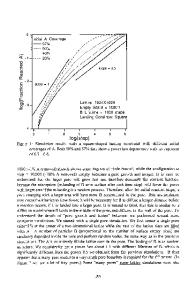Ellipsometric Study of the Interface Between Silicon and Silica
- PDF / 408,160 Bytes
- 7 Pages / 414.72 x 648 pts Page_size
- 101 Downloads / 381 Views
In the present work we measured properties of the silicon-Si0 2 interface with the ellipsometer, and oxide film thickness with the electron microscope. This independent measurement of film thickness allowed us to calculate optical properties of the oxide and interface from various models, and to examine interfacial properties from them. We used various organic16liquids as ambients to amplify the effects from the interface, as previously 1 done by others. ' 7 Experimental Methods Silicon wafers with (100) orientation of surface planes were used. They were either p(boron) or n(phosphorous) type, with resistivities of 5 to 10 ohm-cm. They were cleaned with a modified RCA method, with a final HF etch, rinse, and spin dry. Each oxide film of different thickness was grown directly, without interruption. The oxides grown at 8000 and 850° were in 100% oxygen; those at 9000, 10000 and 11000 were in 10% oxygen - 90%
nitrogen. Many more details of wafer preparation and oxidation are in Ref. 1. A layer of polysilicon was deposited on wafers for observation in the transmission electron microscope; thinned regions for observation were prepared by the methods of Bravman and Sinclair' 8. Several slabs cut from a wafer were glued together, polished to about 10 jm thickness, dimpled, and thinned by ion milling, and observed in a JEOL 100-CX or Philips CM 12 electron microscope at 100 KV. More details of these measurements are in Ref. 1and will be published. Ellipsometric A and * values were measured with an ellipsometer built in the laboratory of Profs. Wayner and Plasky, Chemical Engineering Department, Rensselaer, with laser light of wavelength 632.8 nm and an angle of incidence of 70.000. Measurements from five points on each wafer and from three different wafers oxidized at the same time were averaged for each thickness (time). The variations in calculated thickness across the wafer and between wafers were less than 1%. The A and * measurements can be made to about + .010; however, the standard deviations of the five measurements of A on a single wafer were about .20, and between the means for different wafers about .1Y.The deviations for psi values were about half those of delta. Thus the limiting factor in the accuracy of the ellipsometric measurements was the variation across and between wafers. If the same point on a particular wafer is studied without heating, for example in the successive etching experiments of Taft and Cordes,9 greater accuracy is possible. A cell of Pyrex borosilicate glass held the wafer so it could be immersed in various liquids during ellipsometric measurements. The cell windows were annealed to remove residual strain; errors introduced by the empty cell in air were less than .15' for A and ± .05' for *. The immersion liquids and their refractive indices at 632.8 nm were benzene, 1.495; 29.2% carbon tetrachloride 70.8% benzene, 1.484; acetone, 1.360; methanol, 1.330. Experimental Results Ellipsometric A and * values are plotted as a function of the thickness measured by electron microscopy in Fig. 1.
Data Loading...



